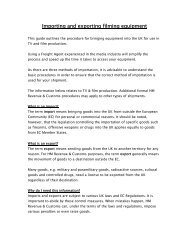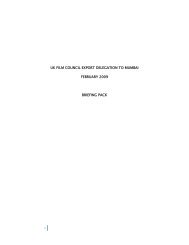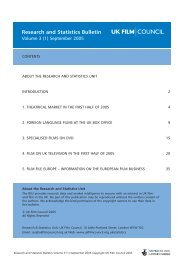Developing an environmental strategy for UK film - BFI
Developing an environmental strategy for UK film - BFI
Developing an environmental strategy for UK film - BFI
You also want an ePaper? Increase the reach of your titles
YUMPU automatically turns print PDFs into web optimized ePapers that Google loves.
Impacts of Climate Ch<strong>an</strong>ge: Flooding<br />
Major floods usually happen on average every 100 years, with climate ch<strong>an</strong>ge this may now<br />
happen every 10 or 20 years. By 2020, most areas of Europe are likely to see <strong>an</strong> increased flood<br />
risk; 7 by the 2080s up to 100 million people worldwide could be at risk of flooding. Much of<br />
southern Britain is sinking, increasing the risk of flooding <strong>an</strong>d coastal erosion, particularly in the<br />
south <strong>an</strong>d east of Engl<strong>an</strong>d (Figure 6). The higher the me<strong>an</strong> sea level the worse storms <strong>an</strong>d erosion<br />
will be.<br />
Five million people in Engl<strong>an</strong>d <strong>an</strong>d Wales are at risk from flooding every year. Two million<br />
homes have been built in the natural floodplain of rivers or the coast which are vulnerable to<br />
flooding; the total fin<strong>an</strong>cial cost of all of the property, l<strong>an</strong>d <strong>an</strong>d assets in these areas has been put<br />
at a value of £214 billion. Insur<strong>an</strong>ce comp<strong>an</strong>ies are faced with increasing bills <strong>an</strong>d will there<strong>for</strong>e<br />
either put up their premiums enormously, cut the level of cover they offer, or in some cases refuse<br />
to ensure homes in high risk areas.<br />
Major l<strong>an</strong>dmarks, tourism destinations <strong>an</strong>d industrial areas within <strong>an</strong>d around London are found<br />
in areas which are very vulnerable to increasing flood risk, such as the business <strong>an</strong>d fin<strong>an</strong>ce areas<br />
in C<strong>an</strong>ary Wharf. Fortunately, the Thames Barrier c<strong>an</strong> still protect vulnerable areas. Between<br />
New Years’ Day <strong>an</strong>d 8 J<strong>an</strong>uary 2003 the Thames barrier was closed 14 times (double the<br />
previous record of seven consecutive closures during the floods of October 2000). However,<br />
heavy rain c<strong>an</strong> result in severe, but localised flooding, which the Thames Barrier c<strong>an</strong>not prevent.<br />
London’s Victori<strong>an</strong> sewage system c<strong>an</strong> be easily overloaded in heavy rain; properties c<strong>an</strong> be<br />
flooded <strong>an</strong>d large amounts of raw sewage released into water bodies. During August 2004 heavy<br />
rainfall in London led to pollution killing thous<strong>an</strong>ds of fish, sewage debris, a foul smell along the<br />
<strong>for</strong>eshore of the tidal Thames <strong>an</strong>d signific<strong>an</strong>tly increased E. coli levels in the river.<br />
Impacts of Climate Ch<strong>an</strong>ge: Sea Level Rise<br />
A signific<strong>an</strong>t sea level rise is one of the major <strong>an</strong>ticipated consequences of climate ch<strong>an</strong>ge. As<br />
temperatures rise the sea absorbs heat from the atmosphere causing it to exp<strong>an</strong>d, thus creating sea<br />
level rises, <strong>an</strong>d l<strong>an</strong>d glaciers will continue to melt over the coming century which will further<br />
increase sea levels. Although there is still uncertainty <strong>an</strong>d scientific disagreement as to how<br />
much sea levels will rise, it is generally accepted that they will rise. Estimates r<strong>an</strong>ge from 9cms<br />
to over 1 metre. Figure 7 illustrates what London will look like after a metre sea level rise.<br />
A rise of a metre or more would be disastrous <strong>for</strong> major coastal cities, greatly increasing the risk<br />
of devastating storm surges, displacing millions of people from their homes, losing thous<strong>an</strong>ds of<br />
km 2 of l<strong>an</strong>d use <strong>an</strong>d causing millions of pounds of damage, all which will severely affect the<br />
economy (Table 2). Even a small increase in sea level will increase the risk of serious flooding in<br />
the Thames Estuary, which could cause the withdrawal of insur<strong>an</strong>ce cover <strong>an</strong>d the collapse of the<br />
property market. Consider the loss of l<strong>an</strong>d area directly relating to <strong>UK</strong> <strong>film</strong>, such as the <strong>BFI</strong> on<br />
the Southb<strong>an</strong>k, plus the associated urb<strong>an</strong> disruptions <strong>an</strong>d the impact this would have on the<br />
industry (Figures 6 <strong>an</strong>d 7).<br />
7 Europe has already experienced severe floods : August 2004, Boscastle Cornwall, saw 8 inches of rain fall in 24 hours, approx 2 million<br />
tonnes (440 million gallons) of water; July 2005, Rom<strong>an</strong>ia, flooding causing damages 25,000 properties, estimated €650 million damage.<br />
Version 1.0 - 8 -

















